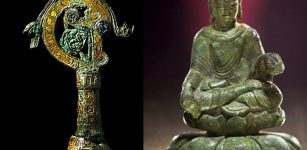Ancient Temple Dedicated To Aztec God Xipe Totec Discovered In Mexico Reveals A Gruesome Story
Conny Waters - AncientPages.com - Xipe Totec was an Aztec god worshiped by people across what is now central and western Mexico and the Gulf coast. It was a fearsome deity who according to the Aztecs invented war.
He was known under different names such as Tlatlauhca, Tlatlauhqui Tezcatlipoca and Youalahuan. In Aztec mythology he was as the god of life, death and rebirth as well as agriculture.
Xipe Totec as depicted in the Codex Borgia, shown holding a bloody weapon and wearing flayed human skin as a suit. Credit: Public Domain
Nevertheless, Xipe Totec ("The Flayed God") was mostly associated with gruesome sacrifices. Wearing a pointed cap and rattle staff he was often depicted without his skin as as a golden god. Aztecs believed Xipe Totec had flayed himself to give food to humanity.
His great temple Yopico was located in the capital city of Tenochtitlan, which is now Mexico City.
As mentioned earlier on Ancient Pages, Templo Mayor was a sacred Aztec complex dedicated to several gods like Tlaloc and Huitzilopochtli who were usually appeased with human sacrifices. Within this complex, Aztecs also built a temple in honor of Xipe Totec ("The Flayed God").
Among the ruins of the Ndachjian-Tehuacan, an archaeological site in the central state of Puebla archaeologists have discovered an ancient temple dedicated to god Xipe Totec.
The temple was used from around the year 1000 until about 1260. Horrible sacrifices took place there. According to Mexico's National Institute of Anthropology and History, the temple’s priests ritually sacrificed their victims on one of the temple's two circular altars, then flayed them on the other and draped themselves in their skin, Associated Press reports.
The Ndachjian–Tehuacan archaeological site in Tehuacan, Puebla state, Mexico. Credit: AP/Mexico's National Institute of Anthropology and History.
At the site Ndachjian-Tehuacan, scientists unearthed “three stone sculptures of Xipe Totec: two skinned heads and a torso, whose back is covered in engravings representing the sacrificial skins worn by the god.
See also:
Linked Human Skeletons Lying In Spiral Circle Unearthed In Pre-Aztec Burial Pit Near Mexico City
500-Hundred-Year-Old Mystery Of Aztecs’ Death May Have Been Solved – New Study
Was Aztec And Mixtec Turquoise Mined In the American Southwest?
"Sculpturally speaking it's a very beautiful piece. It measures approximately 80 centimeters (30 inches) tall and has a hole in the belly, which according to historical sources is where a green stone was placed to 'bring it to life' for ceremonies," said Noemi Castillo Tejero, the lead archaeologist on the project.”
As one of the most important gods in pre-Hispanic Mexico, Xipe Totec was worshipped in a ceremony called Tlacaxipehualiztli, which in the indigenous Nahuatl language means "to wear the skin of the flayed one."
A statue of Xipe Totec, a pre-Hispanic god whose priests sacrificed humans and then wore their flayed skins on their own backs as part of a fertility ritual in what is now Mexico. Credit: AP/Mexico's National Institute of Anthropology and History .
Researchers say “sacrificial victims were killed either through gladiatorial combat matches or by being shot with arrows, then flayed to glorify Xipe Totec, it said.
Their skins were then buried at the foot of the altars.
Two holes filled in with earth were found in front of the altars at the Ndachjian-Tehuacan site.”
When the Spanish conquistador Hernan Cortes and his army arrived in and took over Mexico they put an end to these horrifying rituals.
Written by Conny Waters – AncientPages.com Staff Writer
More From Ancient Pages
-
 Mystery Of The Lost Continent Destroyed By An Ancient Cataclysm – Mysterious Islands – Part 2
Featured Stories | Aug 16, 2021
Mystery Of The Lost Continent Destroyed By An Ancient Cataclysm – Mysterious Islands – Part 2
Featured Stories | Aug 16, 2021 -
 On This Day In History: Storming Of The Paris Fortress – Prison Bastille – On July 14, 1789
News | Jul 14, 2016
On This Day In History: Storming Of The Paris Fortress – Prison Bastille – On July 14, 1789
News | Jul 14, 2016 -
 Luxor – Ever-Lasting Legacy Of The Ancient Egyptian Civilization And The Pharaohs
Featured Stories | Mar 29, 2021
Luxor – Ever-Lasting Legacy Of The Ancient Egyptian Civilization And The Pharaohs
Featured Stories | Mar 29, 2021 -
 The Helgö Treasure: Bronze Buddha Statue, Coptic Scoop And A Crozier Depicting Biblical Tale Of Jonah
Artifacts | Mar 10, 2023
The Helgö Treasure: Bronze Buddha Statue, Coptic Scoop And A Crozier Depicting Biblical Tale Of Jonah
Artifacts | Mar 10, 2023 -
 Unique discovery of unknown inscription may change the history of scripts as we know it.
News | Aug 23, 2015
Unique discovery of unknown inscription may change the history of scripts as we know it.
News | Aug 23, 2015 -
 Motilla del Azuer: Impressive And Unusual 3,200-Year-Old Fortress
Featured Stories | Nov 13, 2018
Motilla del Azuer: Impressive And Unusual 3,200-Year-Old Fortress
Featured Stories | Nov 13, 2018 -
 7,000-Year-Old Underwater Road Discovered In Adriatic Sea Off Korcula Island
Archaeology | May 11, 2023
7,000-Year-Old Underwater Road Discovered In Adriatic Sea Off Korcula Island
Archaeology | May 11, 2023 -
 Ancient Bronze Ring Bearing The Image Of St. Nicholas May Have Been Worn For Protection
Archaeology | Dec 28, 2021
Ancient Bronze Ring Bearing The Image Of St. Nicholas May Have Been Worn For Protection
Archaeology | Dec 28, 2021 -
 DNA Sheds New Light On The Mysterious Dead Sea Scrolls
Archaeology | Jun 2, 2020
DNA Sheds New Light On The Mysterious Dead Sea Scrolls
Archaeology | Jun 2, 2020 -
 Oldest Living Culture: Research Reveals Indigenous Ritual Spanning 500 Generations
Featured Stories | Jul 9, 2024
Oldest Living Culture: Research Reveals Indigenous Ritual Spanning 500 Generations
Featured Stories | Jul 9, 2024 -
 Home Of The Gods – The Return Of The Gods – Part 3
Civilizations | Jun 14, 2018
Home Of The Gods – The Return Of The Gods – Part 3
Civilizations | Jun 14, 2018 -
 The Magnificent Yule Goat In Gävle, Sweden Has Finally Arrived
Christmas Traditions | Dec 2, 2024
The Magnificent Yule Goat In Gävle, Sweden Has Finally Arrived
Christmas Traditions | Dec 2, 2024 -
 Hua Mulan – Chinese Brave Female Warrior In Disguise Who Fought Instead Of Her Old Father
Featured Stories | Sep 30, 2024
Hua Mulan – Chinese Brave Female Warrior In Disguise Who Fought Instead Of Her Old Father
Featured Stories | Sep 30, 2024 -
 El Volcán: Mysterious Volcano-Shaped Pyramid With Never Revealed Secrets In Peru
Archaeology | Jun 6, 2017
El Volcán: Mysterious Volcano-Shaped Pyramid With Never Revealed Secrets In Peru
Archaeology | Jun 6, 2017 -
 For The Ancient Maya, Cracked Mirrors Were A Path To The World Beyond
Featured Stories | May 25, 2024
For The Ancient Maya, Cracked Mirrors Were A Path To The World Beyond
Featured Stories | May 25, 2024 -
 How Ancient Cultures Explained Comets And Meteors
Archaeoastronomy | Jun 5, 2019
How Ancient Cultures Explained Comets And Meteors
Archaeoastronomy | Jun 5, 2019 -
 Unusual Ancient Skull Found In Chan Hol Underwater Cave Reveals Early American Settlers Were Morphologically Different
Archaeology | Feb 6, 2020
Unusual Ancient Skull Found In Chan Hol Underwater Cave Reveals Early American Settlers Were Morphologically Different
Archaeology | Feb 6, 2020 -
 Curtana – Sword Of Mercy Once Belonged To The Anglo-Saxon King Edward The Confessor And Perhaps Even The Arthurian Hero Tristan
Artifacts | Jul 16, 2017
Curtana – Sword Of Mercy Once Belonged To The Anglo-Saxon King Edward The Confessor And Perhaps Even The Arthurian Hero Tristan
Artifacts | Jul 16, 2017 -
 Mysterious Ancient Mayan ‘Copernicus’ And The Venus Table Of The Dresden Codex: The Hieroglyphs Have Been Misunderstood – Researcher Says
Archaeology | Aug 23, 2016
Mysterious Ancient Mayan ‘Copernicus’ And The Venus Table Of The Dresden Codex: The Hieroglyphs Have Been Misunderstood – Researcher Says
Archaeology | Aug 23, 2016 -
 Giants Did Exist And Were A Part Of Earth’s Ancient History
Featured Stories | Apr 29, 2014
Giants Did Exist And Were A Part Of Earth’s Ancient History
Featured Stories | Apr 29, 2014



